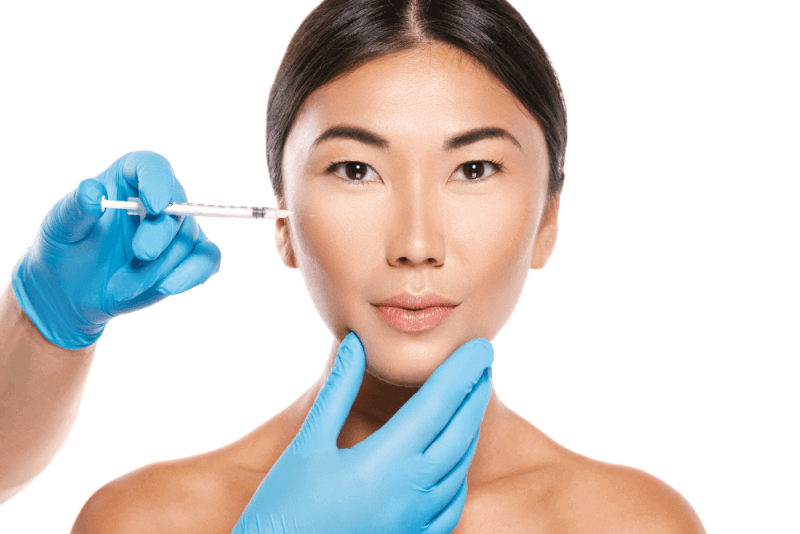What Is Cheekbone Filler?
Cheekbone filler enhances the volume of the cheeks and helps define the cheekbones. The procedure typically involves filling the area around the cheekbones with various substances.
This procedure, which makes the cheekbones more prominent, can take between 15 minutes to 2 hours, depending on the specifics of the application. Cheekbone filler is a non-surgical cosmetic procedure. Several types of filler materials are available, and the appropriate filler is selected based on the individual's needs and the specifics of the procedure.
How Is Cheekbone Filler Applied?
Before applying the cheekbone filler, a local anesthetic cream is used to prevent any pain or discomfort from the injection process. The area is then sterilized to prevent infection. Some fillers contain anesthetic agents, so local anesthesia may not be necessary, depending on the filler used.
Fine needles are used to inject the filler material under the skin in the target area. If necessary, multiple injections may be made at the same point. After the procedure, cold application is done to prevent redness or bruising. However, some swelling and redness may occur, lasting a few days after the procedure.
Why Is Cheekbone Filler Done?
Cheekbone filler is a preferred method for individuals who are dissatisfied with the symmetry of their face. Additionally, fuller cheekbones contribute to a more youthful appearance of the face and skin. The filler procedure also helps reduce wrinkles in the area.
Post-Care for Cheekbone Filler
After cheekbone filler, individuals can resume their daily activities without interruption. However, there are some important points to consider, including:
- Avoid massaging the injection site for a few days after the procedure.
- Apply ice to the area to minimize swelling.
- Avoid getting water on the face for 24 hours after the injection.
- Do not apply makeup for 24 hours after the procedure.
- Avoid sleeping face down for a few days after the procedure.
- Avoid very hot environments after the procedure.
When Does Swelling After Cheekbone Filler Subside?
Swelling is expected after cheekbone filler injections. The swelling typically subsides within 2-7 days. Applying ice periodically after the procedure can help reduce the swelling more quickly.
Types of Cheekbone Fillers
Various filler materials are used in cheekbone filler procedures depending on the purpose of the application and the individual's needs.
Hyaluronic Acid
Hyaluronic acid is the most commonly used filler material in cheekbone fillers. This substance is naturally found in the muscles, joints, skin, and eye fluids of the body. Therefore, it is frequently used not only in cosmetics but also in treating joint and muscle-related problems.
As the skin ages, the amount of hyaluronic acid in the skin decreases, leading to wrinkles and other signs of aging. Therefore, hyaluronic acid is used to reduce wrinkles and increase volume. When hyaluronic acid is used in cheekbone fillers, the effects last for about 1 year.
Calcium Hydroxylapatite
This substance, naturally found in bones, is another filler material used in cheekbone fillers. The effects of this filler can last for up to 15 months.
Polylactic Acid
This synthetic substance stimulates the body to produce its own collagen. It is generally used to treat deep wrinkles in the cheeks. When this filler material is used, the results can last for up to 2 years.
Polymethylmethacrylate
This collagen-based filler material is used to treat moderate wrinkles. Its effects can last for years, but it typically requires multiple sessions for full results.
Who Should Not Get Cheekbone Filler?
As with many cosmetic procedures, there are certain conditions under which cheekbone fillers should not be performed. The main contraindications include pregnant or breastfeeding women. Additionally, the following conditions may also contraindicate the use of cheekbone fillers:
- Allergy to the filler material
- Tuberculosis
- Bleeding disorders
- Skin diseases that could lead to adverse skin reactions from the filler
- Certain autoimmune diseases
- Gum or tooth infections
- Digestive system diseases such as gastroenteritis
- Throat infections
Risks of Cheekbone Filler
Although cheekbone fillers are generally safe, they do carry some risks. These risks include:
- Swelling
- Bruising
- Tenderness
- Bleeding
- Hives
- Acne-like bumps
- Itching
These complications typically resolve within 1-2 weeks. However, there are more serious complications that may occur. Serious complications include:
- Allergic reaction to the filler material
- Swelling
- Migration of the filler to other tissues
- Discoloration of the skin
- Blockage of blood vessels
- Vision loss
- Tissue loss







